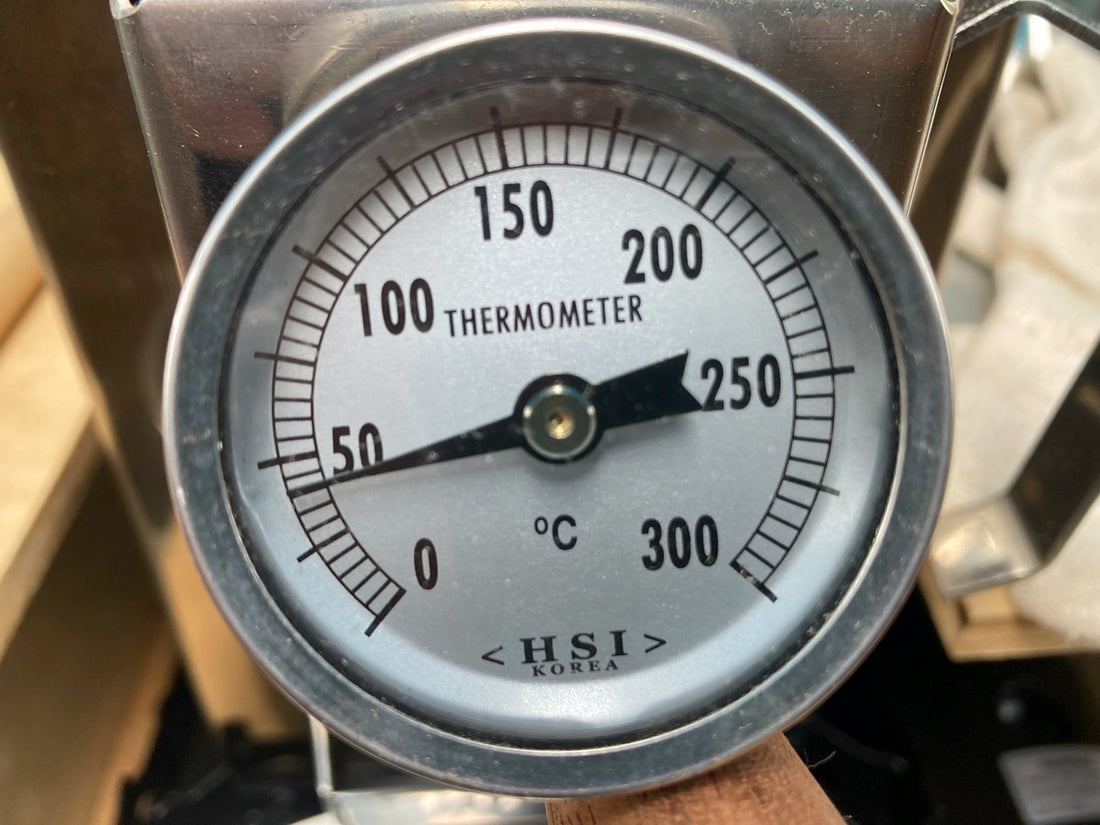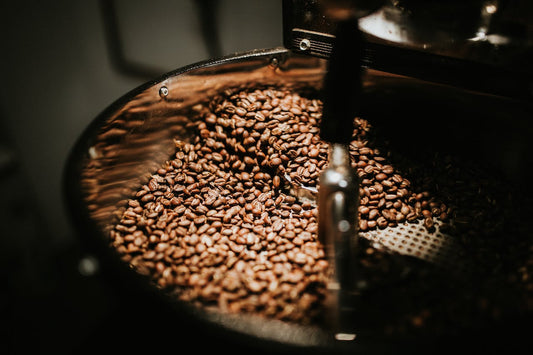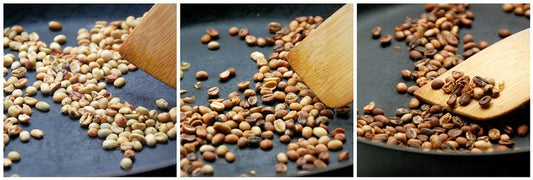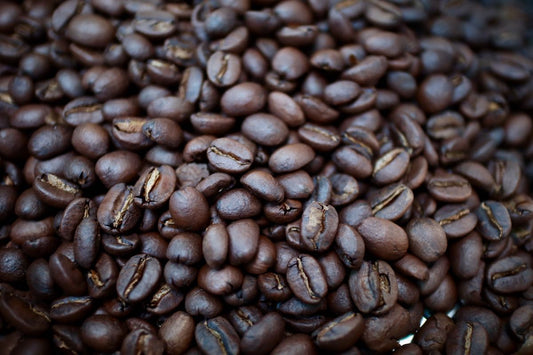
Coffee Roasting Temperatures
Have you ever wondered about of coffee roasting temperatures, where do the stages of coffee roasting change, and what temperatures are related to roast levels?
As a coffee enthusiast, understanding how roasting temperatures influence the taste, aroma, and characteristics of your roast can elevate your coffee game to a whole new level.
Let's dive into the world of coffee roasting temperatures and unveil the magic behind that perfect cup.
Stages of Coffee Roasting
We've detailed out the stages of roasting coffee before, so in this article we're focused more on the temperatures related to each of the stages.
A quick note, we're assuming that your beans temperature at the charge point will be the same as the ambient room temperature. Since we don't know what your room temp is, we'll going to skip that stage and move right into drying.
Drying Phase
The journey begins with the drying phase, this is where green coffee beans lose their moisture.
Visually you'll konw you've reached the end of the drying stage as the coffee will have lost all of it's green coloring but hasn't yet started to brown.
Roasting temperatures during this phase range from ambient temperature to around 172°C (342°F).
As moisture evaporates, the beans undergo significant chemical changes that set the stage in the next stage of roasting.
Browning (Maillard Reaction)
Once the coffee beans have lost their moisture they will start to brown.
You'll first see this just past the drying phase at around 174°C (346°F) as the beans shift from yellow to a yellow-tan color.
At temperatures ranging from 174-205°C (346-402°F), browning is taking place quickly.
This chemical reaction between amino acids and sugars is responsible for the delightful array of flavors and aromas we associate with coffee.
Throughout this temperature range you'll begin to smell the rich aromas of carmelization as your roll progress through.
It's during this phase that the beans develop their complex origin flavor charistics and characteristicly brown color
Development Phase
The period between 196-246°C (385-474°F) is the development phase. Here, the coffee's flavor, acidity, and body reach a delicate equilibrium.
Timing is crucial – a few seconds can make a significant difference in the cup.
Within the Development Phase, there are 3 key things every roast pays a great deal of attention to.
The first is first crack.
First Crack
Around 196-205°C (385-401°F), you'll hear the eagerly awaited "first crack." This distinct popping sound signals the release of steam and carbon dioxide from within the beans.
The first crack marks the initial stage of roast development and plays a pivotal role in defining the coffee's final taste.
It's also the starting pointof the development phase.
Here, the coffee's flavor, acidity, and body reach a delicate equilibrium.
The Time in the Middle
Between first crack and second crack is where most coffee's live.
Of course you can go into dark roasts after second crack, more on that in a moment, but Light to Medium roasts levels all drop somewhere after first crack (196°C) and before second crack (234°C)
You can read more about roast levels and their related characteristics here or the brief summary below.
Second Crack
As the temperature climbs to 234-246°C (454-474°F), the "second crack" occurs.
Here the beans emit a softer, quicker cracking sound, revealing darker, oilier beans. This phase contributes to bittersweet and caramelized notes, characterizing medium-dark to dark roasts.
At this point, almost all of the origin characteristics of the bean are overwhelmed by the characteristcs of the roast level.
It's also at this point that we begin our dark roasts.
Dark Roasting
Beyond the second crack, temperatures can range from 234-246°C (454-474°F).
This is where dark roasts come into play. These robust roasts offer intense, smoky flavors with minimal acidity.
A key distinction of a dark roast is the oily surface of the bean.
Think about your Vienna, Italian or French Roasts. That's what you're getting at this point.
Roast Levels and Their Temperatures
As mentioned before, you can read more about Roast Levels and their characteristics here, but here's a brief summary and their related coffee roasting temperatures.
- Light Roast: From the start of first crack 196-205°C to about 222°C. Delicate floral and fruity notes really shine through.
- Medium Roast: Between first and second crack, usually from 222-232°C. A balance of flavor and acidity.
- Medium-Dark Roast: Just before second crack begins at 232-244°C. A richer, full-bodied profile.
- Dark Roast: Into second crack 234°C and through to 246°C. Bold, smoky, and intense.
Suffice it to say, temperature is one the two main contributors to the flavors of your cup. Time is the other one, but we'll talk about that more in depth later.
For now, here are the key impacts of temperature and the characteristics in your cup.
Impact of Roasting Temperatures on Coffee Characteristics
- Flavor: Different temperatures yield diverse flavor profiles, from fruity to chocolaty.
- Acidity: Roast levels influence acidity, with lighter roasts being more vibrant.
- Body and Mouthfeel: Temperatures affect the coffee's body, creating a silky or robust texture.
- Aroma: Roasting transforms aromatic compounds, giving rise to a range of scents.
It goes without saying though, there are are a lot of variables at play here.
In this article, we've stayed focus on the things that happen and their relatively narrow ranges of temperatures.
But there are a lot of factors that impact the temperatures during a roast.
Here's a short list to help get you thinking.
Factors Affecting Roasting Temperatures
- Bean Origin: Beans from various regions respond uniquely to temperature variations.
- Bean Density: Density affects how beans absorb and distribute heat during roasting.
- Altitude and Humidity: Environmental conditions impact roasting dynamics.
- Coffee Roasters: Not all roasters are created the same, and depending on construction and materials, variability will exist.
Wrapping up coffee roasting temperatures
Understanding coffee roasting temperatures, what happens when, unlocks a world possibilities.
Experiment with different beans, times, and roast levels to find your personal coffee nirvana.
With every batch you roast, remember that each bean carries a history of temperatures, transformations, and tales of flavor waiting to be discovered.
Embrace the journey and savor the exquisite results in every delightful cup.
So, fellow coffee adventurer, go forth and roast your way to coffee greatness!



